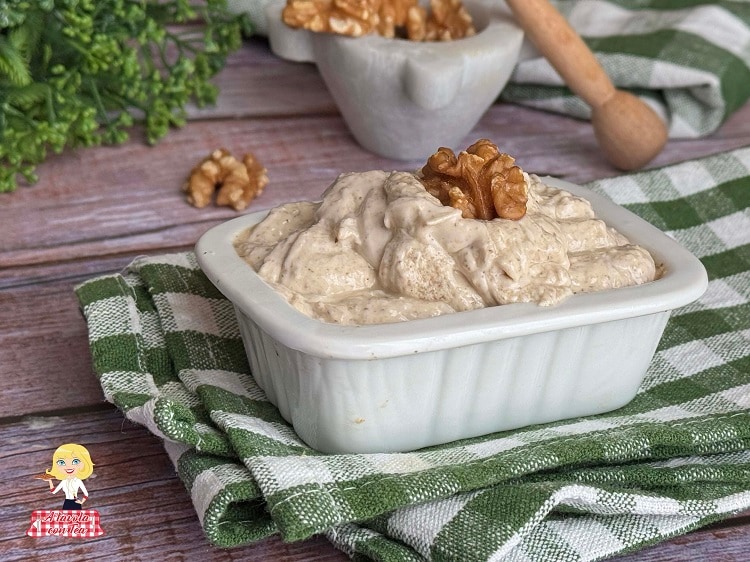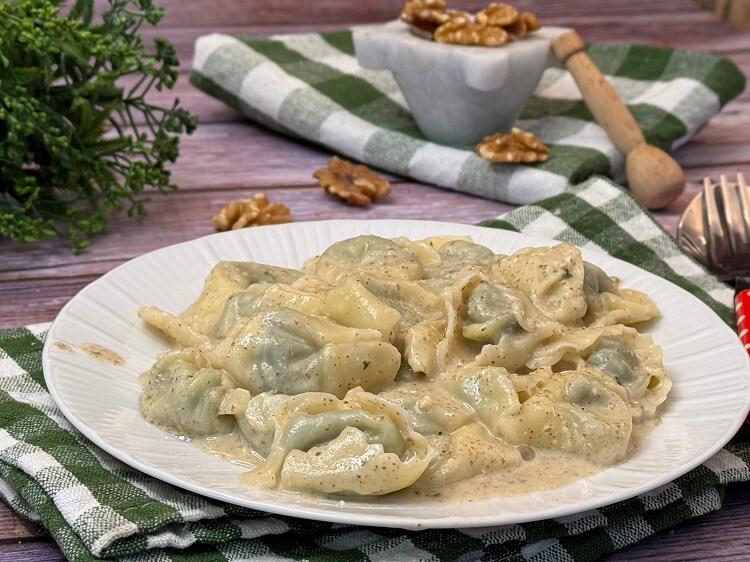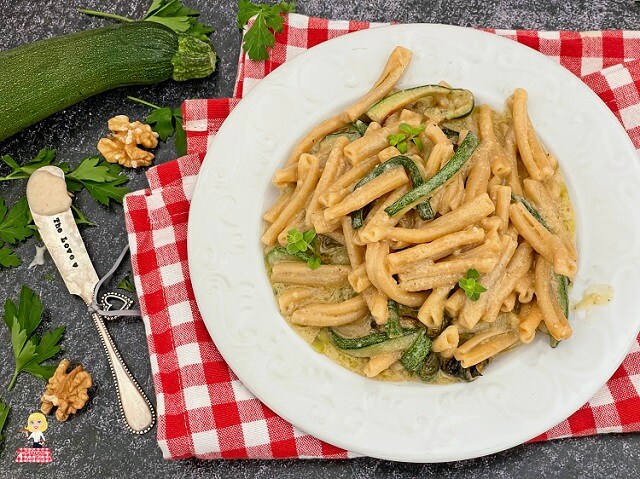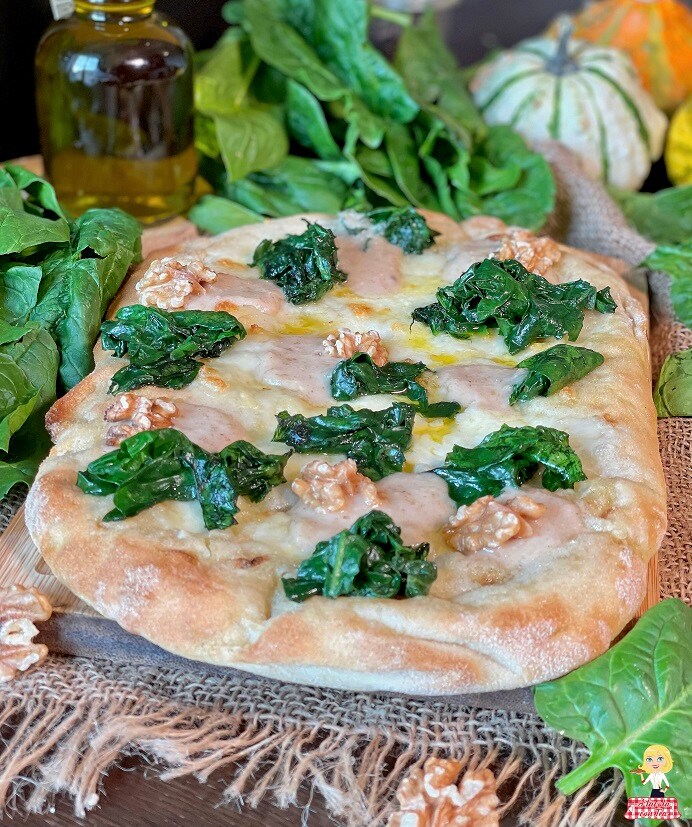WALNUT SAUCE, one of the best GENOESE RECIPES.
One of the most well-known sauces, along with BASIL PESTO, in Ligurian cuisine is undoubtedly walnut sauce, whose classic pairing is with pansotti or pansoti (pasta filled with greens and ricotta) or with lean ravioli (filled with spinach and ricotta).
It is a very tasty sauce made from fresh walnuts that are crushed in a mortar with oil and other ingredients. In fact, for the preparation of walnut sauce, just like pesto, characteristic is the use of a marble mortar, although nowadays almost everyone prepares it with a kitchen robot.
The procedure, as with every typical regional recipe, varies from village to village, and I could also say from family to family, tradition would have the presence of prescinsêua among the ingredients, a whole milk curd typical of Genoa, with a consistency similar to soft ricotta, but with a more acidic taste, mainly used in vegetable pies, but since it is unavailable outside of Genoa, it is usually replaced with milk.
Today I will give you a version of walnut sauce as it was passed down to me, reflecting Ligurian tradition, except for the use of prescinsêua which I will replace with milk as I prefer because it is lighter and more digestible.
This is really a precious recipe, a symbol of genuine, healthy, and light Ligurian cuisine, made of few ingredients but always the right ones, perfect as a seasoning for traditional pansoti, or lean ravioli but also great for trofie, trenette, and lasagna and, why not, also as a sauce on crostini.

- Difficulty: Very Easy
- Cost: Cheap
- Preparation time: 10 Minutes
- Portions: 8
- Cooking methods: No Cooking
- Cuisine: Italian
- Energy 690.16 (Kcal)
- Carbohydrates 14.87 (g) of which sugars 6.32 (g)
- Proteins 13.36 (g)
- Fat 65.49 (g) of which saturated 7.92 (g)of which unsaturated 5.56 (g)
- Fibers 2.59 (g)
- Sodium 135.20 (mg)
Indicative values for a portion of 50 g processed in an automated way starting from the nutritional information available on the CREA* and FoodData Central** databases. It is not food and / or nutritional advice.
* CREATES Food and Nutrition Research Center: https://www.crea.gov.it/alimenti-e-nutrizione https://www.alimentinutrizione.it ** U.S. Department of Agriculture, Agricultural Research Service. FoodData Central, 2019. https://fdc.nal.usda.gov
WHAT YOU NEED TO MAKE WALNUT SAUCE
Walnut sauce is a seasoning made with few and simple ingredients, so it is even more important in this case to choose ingredients that must be fresh and of excellent quality, starting with the walnuts.
- 8.8 oz walnut kernels
- 1.7 cups whole milk
- 5.9 oz extra virgin olive oil
- crumb (of 1 roll)
- 1.8 oz grated Parmesan
- 1.1 oz pine nuts
- 1 clove garlic
- marjoram (1 sprig)
Tools
- Blender
HOW TO PREPARE WALNUT SAUCE
Walnut sauce was traditionally prepared with the classic marble mortar, but nowadays almost everyone uses a blender to prepare it. Below you will find both versions of walnut sauce with the mortar, for a romantic touch to the preparation and the more practical version of walnut sauce with the blender.
First, cut the crumb into cubes and transfer it along with the milk into a bowl. Work it with a fork or with your hands until the crumb has absorbed the milk and you have obtained a granular cream. Place half a garlic clove without the core in the mortar and start crushing it until it becomes a cream, then add the walnut kernels. Crush these as well until you get a creamy but still granular mixture. Add the crumb and mix again with the pestle. Add extra virgin olive oil, marjoram, and Parmesan while continuing to crush. Season with salt and continue working until you obtain a cream. The walnut sauce is ready. Note that compared to the blender method, the walnut sauce with the mortar will always be semi-granular.
First, cut the crumb into cubes and transfer it along with the milk into a bowl. Work it with a fork or with your hands until the crumb has absorbed the milk and you have obtained a granular cream. Transfer the soaked bread into the blender glass. Add all the other ingredients: walnut kernels, a pinch of coarse salt, 1 clove of garlic cut and without the central core, pine nuts, marjoram, grated Parmesan, and lastly, extra virgin olive oil. Start blending and continue until you obtain a smooth and homogeneous cream. Taste and adjust the salt. The walnut sauce is ready!

NOTE
Please remember that WALNUT SAUCE is a cold condiment that, like GENOVESE BASIL PESTO, should absolutely not be cooked or heated. When you dress the pasta, keep aside some cooking water and use a spoonful to thin the sauce if it seems too thick.
TIPS
WALNUTS: Walnut sauce is a simple recipe made with very few ingredients, among which walnuts are the stars. Therefore, make sure to buy quality walnuts, preferably of Italian origin, as foreign ones are often too oily. If you can’t find them shelled, you can buy them still in the shell, as long as the total amount of shelled walnuts equals 250 g. Do not peel them because in this recipe the walnut skin gives the sauce its particular color and flavor, which are the characteristics of this recipe.
MILK: The amount of milk to add changes depending on the type of bread we use in the recipe. Sandwich bread and white bread will absorb a lot of milk, while if we use stale bread like we did, more might be needed.
GARLIC: The original walnut sauce recipe includes garlic, which, however, is only slightly perceptible in the overall taste. If you are allergic, intolerant, or simply do not like garlic, you can omit it.
HOW TO USE WALNUT SAUCE
This is one of the most versatile recipes with walnuts. We can use it as a walnut sauce for pasta and use it to dress linguine, spaghetti, or any short pasta of our choice. Mix it together with the cream using a ladle of cooking water, and we will obtain a well-blended and very tasty sauce. It’s also great for filling sandwiches, piadinas, crostini, and as an accompaniment to vegetables or main courses.




